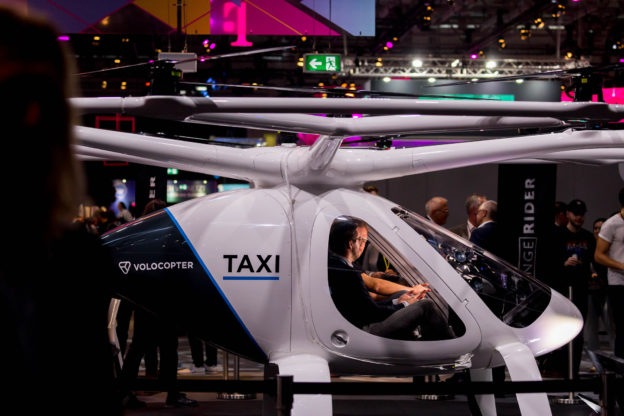
First conceptualized in 2017, the air taxi—a hybrid of drones and electric vehicles—was viewed as a feasible short-term innovation in transportation. Major industry players in the transport sector, including Airbus, Boeing, General Motors, Hyundai, Toyota, and various airlines, joined the future battleground of flying cars and began intensive research and development. Six years later, competition in the air taxi sector has only intensified, and the first certified aircraft is expected to debut next year, transitioning into the manufacturing production phase.
Air taxis, also known as electrical vertical take-off and landing drones, are characterized by their electric propulsion and ability to take-off vertically. With low noise and emissions, they are seen as a solution to future urban transportation challenges.
Silent skies: Electric planes
German drone company Volocopter has made significant strides in the development of air taxis. Backed by a US$30 million investment led by Daimler, the parent company of Mercedes-Benz, the company introduced the VoloCity, an 18-rotor electric aircraft that impressed with its low noise levels. With a hovering noise level of just 65 decibels at a height of 75 meters, the aircraft can be piloted by humans or remotely controlled from the ground.
At this year’s Paris Air Show, Volocoptor’s demonstration went unnoticed by spectators due to the aircraft’s remarkably quiet operation. In contract to the thunderous noise of various jet fighters, attack helicopters, and airliners on display, a Wall Street Journal reported noted that the CEO had to repeatedly remind the audience that their aircraft was taking off. The CEO even equipped that an air condition was louder than the aircraft.
Volocoptor plans to commence passenger operations during next year’s Paris Olympics, offering service with five aircraft from five takeoff points in Paris. However, the company is still awaiting approval from European regulatory authorities to enter full-scale production. European regulators are considering the risks to passengers and ground personnel in densely populated areas, and the US Federal Aviation Administration (FAA) is coordinating certification standards with their European counterparts.
US to designate dedicated air traffic lanes
Major commercial US airlines such as United Airlines, Delta Air Lines, and American Airlines have invested in startups to develop their own air taxi systems, aiming to provide passenger services between airports and city centers. Archer Aviation, a US air taxi company, plans to transport passengers during the 2028 Los Angeles Olympics. United Airlines has already made a US$10 million deposit for 100 out of 200 aircraft covered by their purchase agreement. The company has also formed a production partnership with multinational automobile manufacturer Stellantis and appointed former FAA Chief Billy Nolen as Chief Safety Officer.
The FAA is currently planning dedicated air traffic lanes primarily located between airports and cities for air taxis, with the first taxi expected to receive FAA approval as early as next year. Initially, air taxis will be operated by pilots, but the FAA envisions a gradual shift toward automation, with human operators monitoring from the ground and intervening in emergencies.
Japan is also developing its own flying taxis. SkyDrive, an electric aircraft startup sponsored by Japanese giants like Toyota, NEC, and Panasonic, is collaborating with Suzuki Motor for production and plans to begin manufacturing around next spring. Overall, there may be up to 400 electric air taxi developers worldwide competing to produce the first certified aircraft. As competition intensifies, the number of players in the field will gradually decrease.
(Image Source: Flickr/Marco Verch CC BY 2.0)







